Interior Design Trends and Companies in the UAE
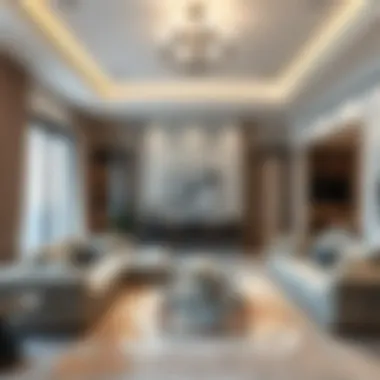
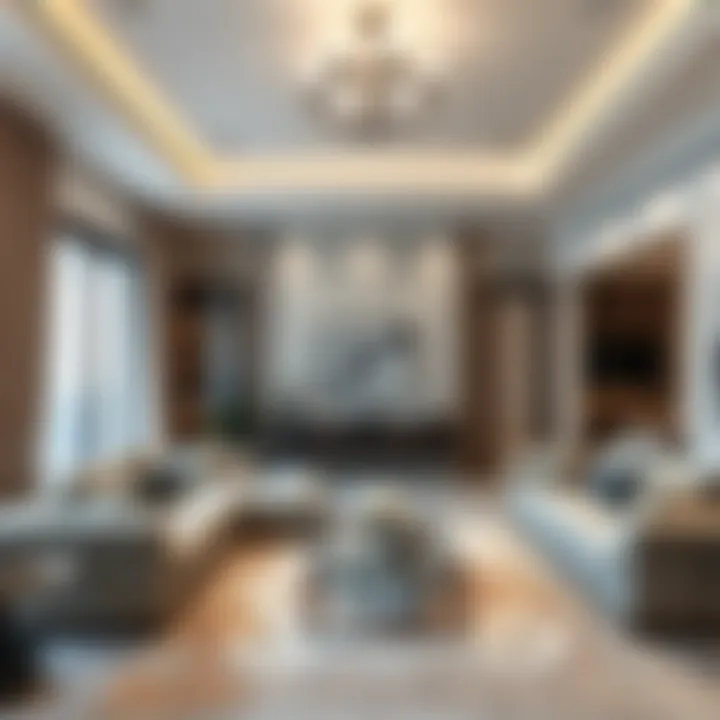
Intro
The interior design landscape in the UAE is as eclectic as the nation itself. With a blend of cultures, traditions, and modern influences, it offers a fascinating tapestry of creativity and innovation. As cities like Dubai and Abu Dhabi continue to expand rapidly, the demand for interior design services is witnessing an upward trajectory. This article takes a closer look at how interior design companies are navigating this vibrant market, exploring trends that are reshaping residential and commercial spaces.
One cannot overlook the influence of cultural diversity on interior design choices in the UAE. From traditional Arabic motifs to contemporary minimalism, the choices are vast. The sophistication of local design firms, along with an influx of international players, creates a competitive marketplace that challenges the status quo and pushes boundaries.
Furthermore, the emphasis on sustainability and eco-conscious designs is gradually taking root in this rapidly developing region. Homeowners, businesses, and investors alike are beginning to realize the importance of integrating sustainable practices into their design strategies. This shift denotes more than just a trend; it reflects a growing awareness of environmental responsibility, particularly in an area known for luxury and opulence.
"The future of interior design in the UAE hinges on a seamless blend of artistry, innovation, and sustainability.”
Armed with insights into design trends and the key players shaping the market, those looking to invest—whether it's realtors searching for commercial spaces, expatriates hunting for stylish homes, or homeowners striving to revamp their living environments—will find this exploration useful. Stay with us as we dissect the various facets of the interior design industry in the UAE and understand how it's evolving to meet the needs of a discerning clientele.
Overview of the UAE Interior Design Scene
The interior design landscape in the UAE is a powerful reflection of the country’s growth and cultural diversity. As the UAE continues to position itself as a hub for business and tourism, the importance of thoughtfully designed spaces is more than ever evident. This exploration delves into the harmony between aesthetics and functionality that defines interior design in this vibrant region.
Historical Context
Understanding the historical context of interior design in the UAE sheds light on how the industry has almost transformed beyond recognition. Historically, the region was characterized by traditional clay homes adorned with intricate wooden designs, drawing on Bedouin influences. The sudden shift towards modernity began with the discovery of oil in the mid-20th century, allowing the Emirates to rapidly evolve. Today, one can witness a mosaic of influences that reflect both the heritage and the modern aspirations of Emirati society.
As cities like Dubai and Abu Dhabi developed, the architectural styles shifted to a more contemporary approach that embraces luxury. Design firms began to incorporate European styles, creating a unique blend that is visually striking yet culturally resonant.
The evolution of government policies promoting tourism and luxury also played a crucial role in this transformation. These changes in societal values and the embracing of globalization paved the way for contemporary design firms to flourish in a market eager for innovative solutions.
Current Trends
The current trends in UAE interior design showcase a fascinating mix of global and local influences. Designers are now leaning towards minimalism with a touch of opulence, creating spaces that are not only stylish but also comfortable and functional.
Some notable trends include:
- Sustainability: An increasing number of firms are adopting eco-friendly practices, reflecting a growing awareness about environmental concerns. This includes using sustainable materials like reclaimed wood and designing spaces that optimize natural light.
- Smart Technology: The integration of smart home technologies has become commonplace. Features such as app-controlled lighting and climate systems are highly sought after, appealing to tech-savvy homeowners and businesses alike.
- Cultural Fusion: Designers are skillfully blending traditional Emirati aesthetics with modern influences, showcasing a visual storytelling that respects the past while looking forward.
Leading Interior Design Companies in the UAE
The exploration of leading interior design companies in the UAE is pivotal in understanding the broader context of the region's architectural and aesthetic evolution. These firms not only shape the visual landscape but also influence lifestyle choices, enhancing how individuals and businesses interact with their environments. The presence of established companies provides stability and a benchmark for quality, while emerging talent brings fresh perspectives, fueling innovation and creativity in design practices.
Established Firms
Established firms in the UAE’s interior design sector stand as pillars of expertise and reliability. Companies like Algedra and Hirsch Bedner Associates have built reputable brands known for crafting spaces that blend luxury with functionality. They have a wealth of experience, having worked on high-profile projects across the region. What sets them apart is not only their capacity to deliver remarkable designs but also their understanding of local cultural nuances that resonate well with both residents and expatriates.
These firms often possess comprehensive service offerings, ranging from conceptual design to project management. Their established networks and resource capabilities enable them to tackle large-scale projects seamlessly, meeting stringent deadlines without compromising quality.
"Well-designed spaces can enhance productivity and well-being, thus transforming mere structures into truly engaging environments for inhabitants."
When engaging with established firms, clients can leverage their experience to avoid common pitfalls. They can also benefit from the insights these companies have gained through years of challenging projects. This depth of experience provides confidence that the project will be executed effectively and efficiently.
Emerging Talent
In contrast, the emerging talents in the UAE’s interior design scene bring an exciting breath of fresh air. Young designers, such as those from Design Haus and KAF Design, are often more attuned to current trends and socio-cultural shifts. They tend to experiment with unconventional styles and techniques, pushing the limits of contemporary design. This generation of designers thrives on collaboration and feedback, often sharing ideas across digital platforms that encourage community engagement.
Emerging designers frequently prioritize sustainability and smart design, reflecting the increasing environmental consciousness among consumers. They are not just designers; they're storytellers, weaving narratives through their creations that echo the aspirations and desires of contemporary society.
Collaborations among emerging talents can lead to groundbreaking projects that challenge established norms. They often embrace a hands-on approach, ensuring that their visions materialize in unique and surprising ways. Such dynamism adds vigor to the UAE’s interior design landscape, creating a balance between the seasoned expertise of established firms and the innovative spirit of new entrants.
Services Offered by Interior Design Firms
The services provided by interior design companies play a key role in shaping living and working environments. These services not only address aesthetic considerations but also consider how spaces can enhance functionality and comfort. Clients, ranging from homeowners to corporate entities, look to designers for their expertise in creating spaces that reflect their visions while meeting practical needs. The importance of these services in the context of the UAE's fast-evolving landscape cannot be overstated.
Residential Design
Residential interior design involves tailoring spaces to reflect the residents’ taste, lifestyle, and comfort. This can mean anything from selecting color palettes to crafting layouts that optimize space usage. In the UAE, where diversity abounds, designers often blend cultural nuances with modern styles. For instance, integrating traditional Arabic elements into contemporary designs can produce stunning results that resonate with both locals and expatriates.
A residential project typically includes:
- Customized Design Concepts: Each home tells a story. Designers work to create a vision that is uniquely aligned with the client’s personality.
- Space Planning: Understanding how a family or individual interacts with their environment is essential. This involves creating functional flow in the layout.
- Material Selection: In the UAE heat, choosing the right materials can make or break comfort. Designers often recommend durable, temperature-regulating materials that also look aesthetically pleasing.
Ultimately, successful residential design fosters a sense of belonging and reprieve from the outside world.
Commercial Spaces
Commercial interior design focuses on optimizing places where people conduct business. The design strategy in this case aims to enhance brand image while ensuring the functionality of the space. In the UAE’s bustling business hubs, companies must stand out, and how their physical environments are designed can say a lot about them.
Key aspects of commercial design include:
- Brand Integration: A company’s identity should ideally reflect in its workspace. Colors, layout, and furniture all contribute to a cohesive branding experience.
- Employee Well-Being: Modern commercial spaces prioritize creating environments that support health and well-being. More plants, better lighting, and comfortable furniture can lead to happier, more productive staff.
- Flexibility: Commercial spaces increasingly require versatility. Designers create multifunctional areas that can host various events or transitions in layout as business needs evolve.
In this sector, the challenge is to strike a balance between aesthetic appeal and practicality, creating spaces that boost morale and efficiency.
Consultation and Project Management
Beyond design execution, consultation, and project management form the backbone of successful projects. Interior design firms often provide substantial guidance and oversight to keep projects on track.
Core components include:
- Initial Consultation: This first step is critical for understanding client vision, budget, and timeline. Having clear communication from the get-go can save a lot of headaches later.
- Project Coordination: Ensuring that timelines are met and that various contractors work in tandem can be tricky. Project managers step in to maintain oversight and communication.
- Budget Management: Good designers help clients make the most out of their budget. They can suggest alternatives, negotiate with suppliers, and often help avoid unnecessary expenses.
"Expertise in project management can significantly reduce the stress of renovation, making the journey enjoyable rather than burdensome."
In a market like the UAE, where expectations are high and timelines are tight, effective management of design projects is indispensable.
Cultural Influences on Design
Understanding cultural influences in interior design is essential, especially in a diverse and multifaceted region like the UAE. The interior design landscape is not simply a reflection of personal taste; it encapsulates the societal norms, traditions, and aspirations of its inhabitants. In the UAE, where tradition meets modernity, the dialogue between old and new greatly influences design choices. This fusion enriches spaces, making interiors not just aesthetically pleasing but also culturally resonant.
Traditional vs. Contemporary Styles
The pull between traditional and contemporary styles is a vivid example of this interplay. Traditional designs often draw from the rich history of the region, incorporating elements like intricate Mashrabiya woodwork or arched doorways, reminiscent of Islamic architecture. These elements not only serve a functional purpose but also tell a story of heritage. For example, a living space might feature rich textiles and handcrafted pottery, evoking a sense of nostalgia and cultural pride.
On the other hand, contemporary styles bring a breath of fresh air, emphasizing minimalism and functionality. Designs might lean towards sleek lines, neutral colors, and an open floor plan, catering to the modern lifestyle. However, this doesn't mean ignoring cultural heritage. Successful contemporary designs in the UAE often integrate traditional motifs in a subtle way, such as a modern sofa pair with cushions featuring local patterns. This blend not only appeals to expats looking for a touch of home but also resonates with locals wanting to embrace their cultural roots.
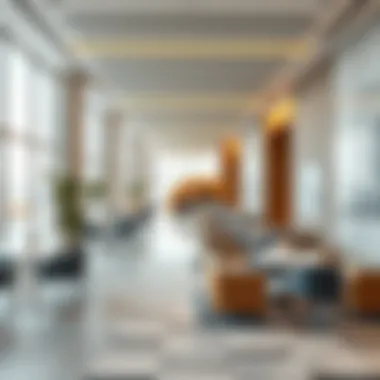
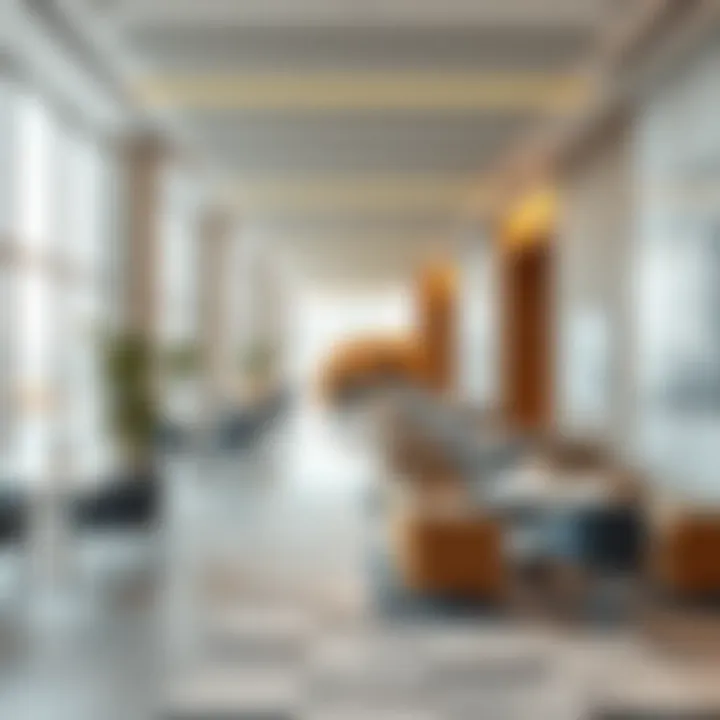
- Key Elements in Traditional Design:
- Features of Contemporary Design:
- Rich textiles and fabrics that evoke history.
- Artisanal craftsmanship that reflects local heritage.
- Architectural features like domes and intricate woodwork.
- Emphasis on open spaces and functionality.
- Use of eco-friendly materials that reflect sustainability.
- Clean lines with fewer decorative elements to create a calm atmosphere.
This ongoing negotiation between the two styles creates a unique design language in the UAE—one that serves not just utility but also honors the legacy of its diverse inhabitants.
Fusion of International Design Paradigms
When talking about the fusion of international design paradigms, the UAE stands at the forefront of blending global influences with local artistry. Various design techniques from around the world intermingle with regional aesthetics, creating interiors that are both cosmopolitan and comforting. From Scandinavian minimalism to Japanese Zen, designers find inspiration across borders, often resulting in innovative outcomes.
For instance, a Dubai marina penthouse might showcase a fusion of Mid-century modern furniture alongside Arabesque tile work, resulting in an aesthetic that appeals widely. The trend of open-plan layouts may draw from Western ideals, but the incorporation of traditional Arab design elements ensures a uniquely UAE experience.
Moreover, exhibitions and international design fairs held in the UAE foster an environment where these paradigms converge. Designers, architects, and homeowners have the opportunity to exchange ideas and learn from global trends, adding a layer of sophistication to locals’ design practices. This continuous cross-pollination is not only beneficial for designers, but also for clients who appreciate a home that reflects a broader cultural narrative.
In summary, cultural influences in UAE interior design embody a harmonious dance between tradition and innovation. It paints a picture of a dynamic community—one that cherishes its past while embracing the future, making it a fascinating landscape for homeowners, investors, and design enthusiasts alike.
"The best designs are those that tell a story, reflecting elements of the past while looking towards the future."
For further exploration on global design influences, you can visit Wikipedia or catch the latest trends on Reddit.
Sustainable Practices in Interior Design
Sustainable practices have carved a niche in the interior design industry, significantly shaping its landscape in the UAE. As awareness of environmental issues grows, designers and companies alike are incorporating sustainability into their projects. It's no longer about simply creating attractive spaces; it’s about ensuring that these environments are environmentally friendly, economically viable, and socially responsible.
The methodologies include careful choices regarding materials and resource management as well as significant considerations around energy efficiency and the technologies that accompany modern interior design.
Materials and Resources
When it comes to sustainability, the materials used in interior design projects can make or break a company’s environmental credentials. Utilizing eco-friendly materials such as reclaimed wood, recycled metals, and low-VOC (volatile organic compounds) products goes a long way in minimizing the overall carbon footprint. For instance, many UAE firms have turned to locally sourced materials to lessen transportation emissions while supporting regional economies.
However, the landscape isn’t always straightforward. Designers face the dual pressure of advocating for sustainable selections while also considering their clients’ aesthetic desires and budget constraints.
Some materials, like bamboo, are gaining traction due to their rapid growth and renewability, making them a favorite in the design community.
- Recycled materials can reduce waste by repurposing what already exists.
- Sustainable textiles are another area worth exploring; brands like Organic Cotton Colors have made eco-conscious fabrics accessible.
By prioritizing sustainable materials and resources, design firms not only contribute positively to the environment but also resonate with a clientele that values responsibility in their design choices.
Energy Efficiency and Technologies
Energy efficiency is a critical component of sustainable interior design practices, especially with rising utility costs and the pressing need to reduce energy consumption. Designers in the UAE are utilizing state-of-the-art technologies to offer energy-efficient solutions that diminish environmental impacts.
Innovations in smart home integration are paving the way for buildings that utilize energy more effectively. For instance, designs incorporating smart lighting and heating systems can adjust automatically based on occupancy levels or time of day, effectively optimizing energy use.
Moreover, implementing passive design strategies—such as maximizing natural light through strategically placed windows or using thermal mass materials—further enhances a building’s energy efficiency. By integrating these systems, companies actively partake in the movement towards more sustainable practices, which not only supports the environment but also saves their clients money in the long run.
"Incorporating smart technologies in design can effectively optimize both the ecological footprint and the energy usage of a space."
As the interior design world in the UAE continues to evolve, the commitment to sustainable practices promises to create lasting impacts. This focus ensures that the future of both residential and commercial spaces is not only chic but also environmentally conscientious.
Technological Innovations in Design
In the ever-evolving landscape of interior design, technological innovations hold a significant place. These advancements are shaping how designers visualize, plan, and execute their projects. Integrating technology not only improves the efficiency of the design process but also enhances the overall client experience. By harnessing tools like Virtual Reality and Smart Home technologies, designers are better equipped to meet the diverse demands of clients in the UAE, a market characterized by its dynamic and cosmopolitan nature.
Virtual Reality and Design Visualization
Virtual Reality (VR) has emerged as a game changer in the interior design industry. This immersive technology allows clients to step into a virtual version of their space before any actual work begins. Imagine walking through a scale model of your future living room, feeling the space, and even exploring various design elements such as color schemes and furniture placements.
This not only aids clients in understanding the spatial dynamics but also enables effective decision-making, thus reducing the likelihood of costly changes later on. With VR, designers can present their concepts in a more engaging manner, fostering a collaborative dialogue with clients. Some of the benefits include:
- Enhanced Visualization: Clients gain a clearer view of the final outcome, bridging the gap between imagination and reality.
- Reduced Costs: Catching design flaws in the virtual stage can save substantial amounts in rework and alterations at later stages.
- Streamlined Communication: Clearer visual aids enhance communication between a designer and a client, often leading to faster approvals.
"Virtual reality is not just a tool, but a new language for visualizing ideas that, until now, existed only in the minds of designers."
This technology is being increasingly adopted by firms throughout the UAE, positioning the country's interior design industry on the cutting edge of innovation. Companies that furnish walkthroughs using VR, such as Sofitel or Zaha Hadid Architects, showcase how technology can enhance the design journey.
Smart Home Integration
As technology continues to seep into our daily lives, Smart Home Integration is quickly becoming a standard expectation in modern design. This refers to incorporating smart devices into interior designs, allowing homeowners to control their environment with ease and convenience. From automated lighting systems to intelligent thermostats that adjust temperatures according to preferences, the possibilities are vast.
The adoption of smart home technology offers several advantages:
- Customization and Flexibility: Homeowners can personalize their living environments according to their routines and preferences.
- Energy Efficiency: Smart features can significantly reduce energy consumption, which is not only cost-effective but also supports sustainability efforts in design.
- Enhanced Security: Smart surveillance systems and alarms enhance the safety of residential spaces, providing peace of mind to homeowners.
Design firms in UAE, like Algedra and KAS Interiors, are embracing these technologies within their offerings, crafting spaces that merge functionality with luxury. They understand the importance of keeping ahead of consumer demands while balancing aesthetic appeal with the practicality that smart features provide.
In summary, technological innovations are not merely trends but essential components that redefine the interior design industry in the UAE. By leveraging tools like Virtual Reality and the Internet of Things, designers are creating spaces that are not only visually appealing but also functional and responsive to client needs.
Challenges in the UAE Interior Design Market
The interior design market in the UAE is as vibrant as the cities themselves; however, it is not without its share of hurdles. Understanding these challenges is crucial for stakeholders like investors, realtors, homeowners, expatriates, and renters, who either seek to leverage the expertise of design firms or wish to navigate the complexities of creating their spaces. The dynamic nature of this market means that professionals must stay vigilant and adaptable.
Regulatory Landscape
One of the primary challenges in the UAE’s interior design market stems from the regulatory landscape. Various governmental bodies oversee numerous aspects of design, from building codes to safety regulations. Designers must navigate a web of local and federal laws, which can be quite daunting. For instance, each Emirate may have its own requirements, which means that what flies in Dubai might not be acceptable in Abu Dhabi.
"The regulatory environment must be viewed not just as a hurdle but as a framework that protects both clients and designers."
This scenario can lead to delays in project timelines and increased costs if firms are not well-versed in these regulations. Additionally, obtaining permits and adhering to sustainable practices — as mandated by current laws — can further complicate the design process. Firms must invest time and resources in understanding these regulations to ensure compliance, which is no small feat.
High Competition Levels
The UAE is teeming with design firms, from established giants to fresh contenders bursting with creativity. This high level of competition can be a double-edged sword. While it fosters innovation and enhances choices for clients, it also means that companies are vying for the same pool of projects, often leading to price wars or compromised quality to attract business.
New designers may struggle to carve out a niche amid these intense competitive pressures. Established firms might leverage their track record, client relationships, and extensive portfolios to retain market share, making it tough for newcomers to gain a foothold. This environment requires emerging designers to not only be adept in their craft but also proactive in building a solid brand presence and networking within the industry.
Furthermore, clients have access to an abundance of choices, leading to heightened expectations for service quality and innovation. As such, firms must remain agile and responsive, constantly refining their offerings and demonstrating value while managing costs.
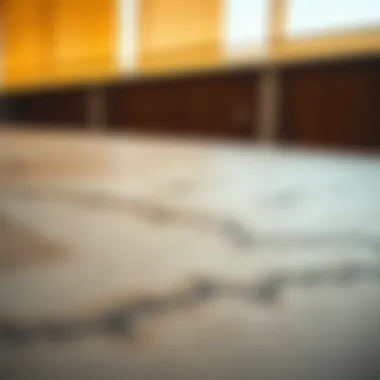
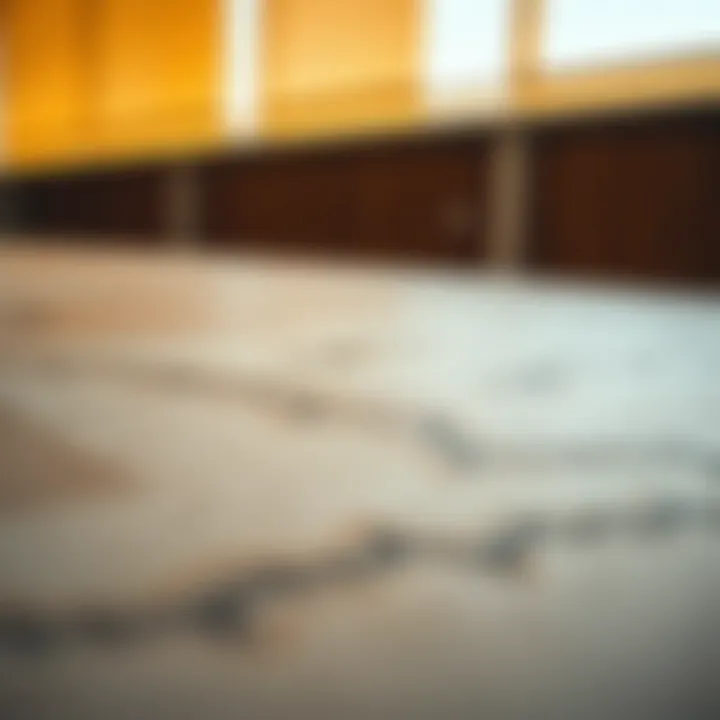
Notable Projects and Case Studies
The interior design landscape in the UAE is not only defined by the firms operating within it but also by the impactful projects that showcase their expertise and vision. Notable projects and case studies are crucial for understanding how design concepts translate into real-world applications, forming a bridge between theoretical frameworks and practical outcomes. These projects serve as benchmarks for quality, creativity, and innovation in the industry while highlighting the unique cultural and functional needs of UAE residents and businesses.
Residential Projects
Residential projects in the UAE are often a reflection of the luxurious lifestyles that many individuals and families aspire to. From sprawling villas in Emirates Hills to modern apartments in Dubai Marina, the choices in design are vast and varied. A prime example is the Palace Residence in Abu Dhabi, known for its elegant blend of traditional Islamic architecture with modern elements. This project goes beyond aesthetics; it incorporates functional living spaces that cater to family dynamics and leisure activities.
These residential designs emphasize the importance of open spaces and natural light, creating an environment that is not just beautiful but also comforting. Clients often seek to personalize their homes in line with their tastes and cultural backgrounds, an aspect that skilled designers navigate with finesse. The wealth of materials available—from opulent marbles to sustainable wood—allows for a range of expressions, ensuring that each project tells a unique story.
Commercial Developments
On the commercial side, the UAE's interior design market shines through noteworthy developments that elevate corporate identities. Projects like the Etihad Towers in Abu Dhabi exemplify how interior design can align with branding while maximizing functionality. The attention to detail in public spaces and office layouts not only enhances aesthetic appeal but also boosts productivity. High-end materials are often employed to create an impression of sophistication and luxury that aligns with the UAE's business ethos.
Furthermore, commercial spaces must cater to diverse clientele and operational workflows. For instance, the Dubai Mall showcases innovative designs that create seamless flows for millions of visitors, integrating retail, dining, and entertainment into a cohesive experience. These projects highlight the necessity for designers to balance artistic vision within the realms of practicality, user experience, and brand representation.
"In the realm of interior design, particularly in commercial developments, success lies in the ability to make spaces functional while reflecting the brand's identity".
By analyzing these notable projects, a deeper understanding emerges regarding the interplay of design trends and cultural influences, showcasing the UAE as a melting pot of innovation and creativity in the field of interior design.
Interior Design Awards and Recognition
The realm of interior design isn’t just about aesthetics; it encompasses creativity, innovation, and a knack for reflecting cultural nuances. Awards and recognition in this field serve as a benchmark for excellence, enabling designers and firms to achieve greater visibility and credibility. They highlight outstanding achievements and encourage a culture of excellence among interior design professionals. These accolades can bolster a company’s reputation, attracting high-profile clients and fostering partnerships that may otherwise remain out of reach.
Local Awards
In the UAE, local awards are crucial for promoting the talent within the region and illustrating the unique design perspectives cultivated there. Awards like the Middle East Interior Design Awards and the FM Awards focus on recognizing the best work across various categories such as residential, commercial, and sustainable design. Participating in these awards not only provides an opportunity for recognition but also offers designers a platform to showcase their skills and creative philosophies.
"Winning local awards is not just an honor; it’s a stepping stone to broader opportunities, encouraging designers to push boundaries and forge their unique paths in the industry."
Winning a local award can boost a firm’s profile significantly. It often leads to increased media attention, allowing firms to feature their work in prestigious publications such as Architectural Digest Middle East or even on platforms like Designboom. Moreover, local awards foster community engagement within the interior design sector, providing networking opportunities between firms, suppliers, and clients.
Overall, participating in local competitions cultivates a spirit of rivalry that propels the industry forward, benefiting both designers and clients alike.
International Recognition
The allure of international design recognition can elevate a firm’s status to a global level. Prizes such as the International Design Awards or the A’ Design Award and Competition attract submissions from across the world, facilitating a platform where UAE designers can present their work on a much larger stage. Achieving international awards not only signals high-quality work but also reflects a firm’s ability to compete with the best minds in the design industry.
International recognition broadens a designer’s portfolio and opens doors to collaborations beyond geographical limitations. Designers gain global visibility, helping them build a brand that resonates with clients across different markets. This kind of exposure is indispensable in today’s interconnected world, where design trends transcend borders.
Future of Interior Design in the UAE
The future of interior design in the UAE holds numerous implications for the industry, investors, and consumers alike. As the country continues to evolve, the design landscape also undergoes changes that mirror shifting preferences, technological advancements, and economic conditions. Understanding these trends and projections helps stakeholders to make informed decisions within this bustling market.
Emerging Trends to Watch
Several trends are taking shape in the UAE’s interior design scene that are critical for professionals and clients alike. Here are a few key observatoins:
- Sustainable Design Practices: As environmental awareness grows, there is a discernible shift toward eco-friendly designs. More firms are incorporating sustainable materials and energy-efficient methods into their projects. This isn’t merely a trend but a vital part of the UAE's vision for sustainable development.
- Minimalism with a Twist: Clean lines and open spaces are making a comeback, however, it's the unique touches that make designs stand out. Combining minimalist aesthetics with local craftsmanship is gaining favor. Think sleek surfaces adorned with traditional materials.
- Smart Home Integration: The demand for smart home solutions is booming. Future designs will increasingly blend technology seamlessly into living and working spaces, enhancing convenience and functionality.
- Biophilic Design: Integrating nature into interior spaces is on everyone’s lips, promoting wellbeing and relaxation. Expect to see more green walls, natural light maximization, and indoor plants as central figures in any design narrative.
"To ignore the relationship between human beings and nature is to put our well-being at risk."
Predicted Market Growth
The interior design market in the UAE is poised for significant growth over the next few years. Several factors are influencing this upward trajectory:
- Economic Diversification: With the UAE's commitment to diversifying its economy, there’s an influx of new businesses and projects, leading to a higher demand for professional design expertise in both commercial and residential spaces.
- Investor Confidence: The sustained interest from foreign investors is boosting confidence across the sector. Initiatives such as the UAE Golden Visa are attracting expatriates, resulting in increased demand for housing and, consequently, interior design services.
- Real Estate Development: Major projects like Dubai Expo 2020, though impacted by global events, continue to pave the way for further developments. The ripple effect of such large-scale investments inevitably fuels the need for innovative design.
- Technological Adoption: The rise of design software and AI tools streamlines processes in the design and construction sectors, enhancing productivity and opening new avenues for customization in interior design.
In a nutshell, the landscape of interior design in the UAE is not just changing; it’s evolving into a more sophisticated, sustainable, and technologically integrated space. Keeping an eye on these trends and growth markers is essential for anyone involved or interested in the market.
For further insights, you can explore relevant resources at Wikipedia, Britannica, or community discussions on Reddit.
The Role of Clients in the Design Process
The involvement of clients in the interior design process is crucial to the overall success of a project. This relationship, characterized by understanding and collaboration, is what ultimately shapes the final outcome. Interior design is not merely about aesthetic; it’s about creating environments that reflect the clients’ personalities, preferences, and lifestyles. Therefore, acknowledging the role clients play is fundamental to creating spaces that are not just functional but also resonate deeply with those who inhabit them.
Understanding Client Needs
A pivotal part of the design journey is understanding the specific needs of the clients. Each client brings a unique set of preferences and requirements, influenced by their culture, lifestyle, and personal taste. Designers must listen actively and ask the right questions to get to the heart of what clients want. For instance, a client might prioritize open spaces and natural light if they are a family that enjoys entertaining guests. On the contrary, a young professional may seek a minimalist design focused on productivity and efficiency.
Key considerations in this phase include:
- Lifestyle Analysis: Understanding how clients live can inform design choices. A busy family may need durable, easy-to-maintain materials, while a single expatriate might lean towards a chic, stylish environment that reflects their urban lifestyle.
- Budget Limitations: Knowing the financial boundaries helps designers propose feasible solutions and helps clients manage expectations.
- Functionality vs. Aesthetics: This balance is critical; while a space should look appealing, it must also serve its intended function. For instance, designing a cozy reading nook that fits seamlessly into the overall aesthetic of a living room.
"The secret to beautiful design is not in the objects themselves, but in how they make people feel."
Collaboration with Designers
Once the needs have been articulated, the collaborative phase begins. This is where the true magic happens. Designers and clients work together, blending creative vision with practical requirements.
Several benefits emerge from effective collaboration:
- Bridging Ideas: Clients bring their visions, while designers offer expertise. Together, they can explore options that meet the functional, aesthetic, and budgetary requirements. This partnership can lead to unexpected design solutions that surpass initial expectations.
- Encouraging Feedback: An open line of communication allows for continuous feedback, ensuring that the design evolves according to client satisfaction. Regular check-ins and presentations of progress can facilitate this process.
- Trust Building: A successful collaboration builds trust. When clients feel their contributions and opinions are valued, it fosters a positive atmosphere. This bond not only makes the process enjoyable but can lead to repeat business and referrals.
In the realm of interior design, clients aren’t just stakeholders; they are co-creators. A design project thrives when the vision encompasses not just the aesthetic but the values and lifestyle of those it aims to serve.
Networking in the Interior Design Community
In the landscape of interior design, networking is the blood that keeps the industry pumping. For professionals and enthusiasts alike, connecting with others in the field can open a multitude of doors, from sharing innovative ideas to landing that next big project. In the UAE, a region known for its diversity and fast-paced development, the interior design community offers unique avenues for individuals to exchange knowledge, explore collaborations, and establish lasting relationships.
Benefits of Networking
Many people underestimate the advantages of a robust professional network, viewing it merely as a series of business cards collected at events. However, in interior design, relationships are often the bedrock of success.
Here are a few key benefits of networking:
- Collaboration Opportunities: Meeting like-minded individuals can lead to partnerships that enrich projects. Collaborative efforts often yield more innovative results than solo endeavors.
- Exposure to New Trends: Through connections, designers can stay updated on international trends and local market shifts, adapting their styles and strategies accordingly.
- Resource Sharing: A solid network allows for the exchange of suppliers, contractors, and consultants, providing invaluable support and streamlining project execution.
- Support System: The creative process can be isolating; having peers to share experiences and seek advice can lessen that burden.
"Networking is not just about collecting contacts; it’s about planting relationships."
— Anonymous
Conferences and Workshops
Conferences and workshops have stood the test of time as prime venues for professional engagement. In the UAE, events specifically focused on interior design draw various professionals from across the region and beyond. These gatherings typically feature:
- Keynote Speakers: Industry leaders share their insights, valuable lessons, and experiences that can inspire new ideas or approaches in one’s work.
- Workshops: Hands-on sessions encourage participants to delve into specific skills like space planning or sustainable design practices. These interactive elements foster deeper learning and potential collaborations.
- Exhibitions: Showcases of the latest products, materials, and technologies provide practical insights into what’s out there, allowing designers to integrate these innovations into their projects.
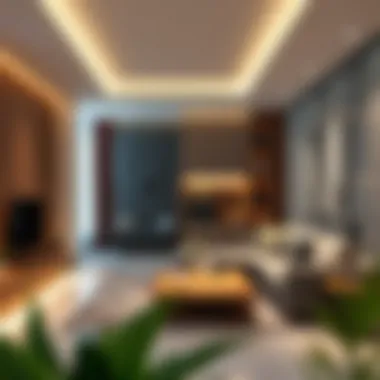
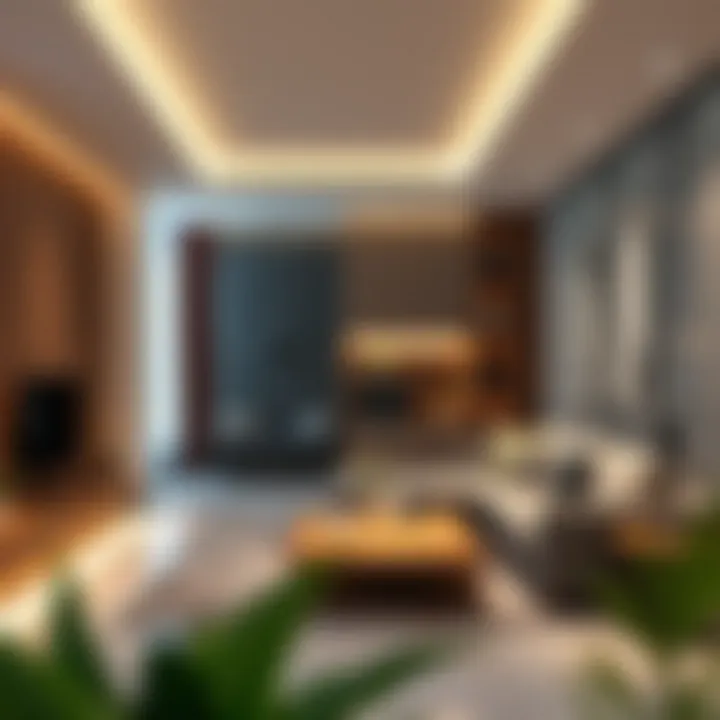
Participating in these events not only enhances one’s technical prowess but also places individuals within a vibrant community, often igniting connections that go far beyond the conference itself.
Online Platforms and Communities
In today’s digital era, online platforms serve as dynamic spaces for networking. Platforms such as LinkedIn, Instagram, and specialized forums like Reddit and Facebook groups enable designers to engage with a global audience. Some advantages of these online communities include:
- Accessibility: Whether you’re based in Dubai or a small town, you can connect across borders, sharing and collaborating with peers from around the world.
- Ease of Information Exchange: Ideas, images, and tips can be shared quickly, making it faster to stay informed about industry shifts and trends.
- Feedback Mechanism: Online communities allow for the sharing of work and receiving constructive criticism from fellow designers, offering new perspectives that may not be available in one’s immediate environment.
These platforms have become essential tools for fostering professional relationships while also serving as a creative outlet. Engaging online not only helps in building a robust professional image but also showcases one’s work in front of a broader audience, further enhancing credibility.
To sum it up, the importance of networkin in the interior design community in the UAE cannot be overstated. Whether through in-person conferences or online platforms, the essence of the industry thrives on connections that inspire collaboration, innovation, and growth.
Educational Pathways for Designers
In the ever-evolving realm of interior design in the UAE, it’s crucial for aspiring designers to understand the educational pathways that lay the groundwork for their future careers. This section highlights how education can shape design professionals and equip them with the skills necessary to thrive in a competitive market. Considering that the UAE is a melting pot of cultures and innovative ideas, the right educational background can make all the difference.
The importance of structured education in interior design cannot be understated. It not only provides foundational knowledge of design principles but also encompasses broader skills such as project management, client communications, and sustainability practices. Furthermore, educational institutions often facilitate networking opportunities with industry leaders and potential employers, which can be invaluable for young designers.
With institutions increasingly offering updated curricula that address current trends, both local and international, it’s beneficial for students to seek programs that emphasize real-world applications. Additionally, as the design landscape becomes more complex with the integration of technology and sustainability, continuing education will remain vital for professional development.
Relevant Academic Programs
Among various academic offerings, degree programs specifically focused on interior design are the stepping stones for many designers in the UAE. Universities such as The American University in Dubai and Zayed University offer accredited bachelor’s degrees that cover the myriad aspects of interior design, combining theory with practical projects. These programs often incorporate elements such as cultural sensitivity in design - crucial for a diverse region like the UAE.
Apart from undergraduate studies,
- Diplomas in interior design provide a fast track into the industry.
- Master’s programs cater to those looking to deepen their expertise, often involving specialized focuses like sustainability or technology integration.
Moreover, some institutions offer short courses in specific skills such as textile selection or color theory, enhancing the designer's toolkit without the long-term commitment of a degree.
Professional Certifications
In a competitive job market, professional certifications can provide an edge. Certifications are an acknowledgment of one's skills and expertise, often required by employers. In the UAE, designers may pursue credentials from organizations like the American Society of Interior Designers (ASID) or the International Interior Design Association (IIDA).
These programs require candidates to pass exams and submit portfolios showcasing their projects, ensuring that certified professionals have practical experience along with academic knowledge. Other certifications focus on specific areas such as sustainable design, which is increasingly relevant as environmental concerns take center stage in building projects.
The key benefits of pursuing certifications include:
- Enhancing credibility in the field.
- Expanding professional networks.
- Staying abreast of the latest design trends and regulations.
"Professional certifications can often open doors that would otherwise remain closed in such a crowded marketplace."
Conclusively, navigating the educational landscape can significantly influence the trajectory of a designer’s career in the UAE. By selecting the right programs and pursuing relevant certifications, aspiring designers can set themselves up for long-term success in the dynamic world of interior design.
Impact of Global Events on Design Strategies
The world of interior design is intertwined with various global events, and the UAE is no exception. In fact, the interconnectedness of economies and cultures has a profound influence on how design strategies evolve. Understanding these influences is crucial for stakeholders in the market, encompassing investors, realtors, homeowners, expatriates, and renters alike.
One of the primary reasons to explore this topic is to appreciate how economic fluctuations reshuffle priorities in design. Economic booms often lead to excessive spending on luxury designs, while recessions force a sharper focus on cost-effective solutions. Buyers become more discerning, weighing aesthetic appeal against practicality. This scrutiny can lead to the rise of a specific trend where timeless design elements are favored over fleeting fads, creating lasting spaces that maintain value in changing markets.
Effect of Economic Fluctuations
The economic landscape can shift overnight, influenced by factors like oil prices, tourism numbers, and political stability. When economic growth is robust, the appetite for extravagant designs surges. This creates opportunities for interior designers to push boundaries, experimenting with bold colors and unique architectural elements. However, during economic downturns, the mood changes significantly. Clients often prefer understated elegance and functional spaces that provide comfort without excessive embellishment.
For example, during a boom in the mid-2010s, many design firms in the UAE responded by incorporating opulent materials like marble and gold leaf into their projects. In contrast, as the economy began to face challenges later on, an increasing number of clients gravitated towards sustainable, yet stylish solutions. Designers found themselves innovating with recycled materials and multipurpose furniture, emphasizing a return to simplicity without sacrificing beauty.
Pandemic-Driven Changes in Design Preferences
The onset of the COVID-19 pandemic has led to seismic shifts in design preferences, particularly within the UAE, a country known for its luxurious and bustling lifestyle. As lockdowns became a reality, the focus shifted to creating comfortable yet functional living spaces. Homeowners began transforming spare rooms into home offices or gyms, illustrating a newfound emphasis on versatility in design.
Moreover, the pandemic showcased the importance of natural light and ventilation in spaces, leading to increased demand for designs that embrace these elements. Consequently, many designers are now opting for open-plan layouts that provide a sense of spaciousness while maximizing light.
"In the wake of the pandemic, clients are prioritizing wellness in design—spaces need to feel safe, soothing, and functional, as our homes are now our sanctuaries."
Additionally, with more people working from home, there's a heightened awareness of noise control and privacy. Designers are exploring acoustic panels and soundproofing solutions as essential components in modern homes, providing a retreat from the outside world's hustle.
In summary, global events, whether economic or health-related, play a pivotal role in shaping design strategies within the UAE. For stakeholders looking to invest or engage in the interior design arena, understanding these dynamics is necessary for making informed decisions. As the culture of design adapts, so too must the approaches of those involved in transforming the spaces we live and work in.
Consumer Trends Influencing Design Choices
Understanding consumer trends is crucial in shaping the practices of interior design companies in the UAE. As society evolves, so do the desires and expectations of clients. This section delves into the shifting sands of consumer preferences and the delicate balance between aesthetic appeal and functionality.
Shifts in Consumer Preferences
Recent years have shown a marked shift in what people want from their spaces. For instance, where once grandiosity ruled the day, a growing number of consumers are favoring simplicity and minimalism. The rise of remote working has not only changed how people view their living spaces but also how they utilize them. A space that once served purely aesthetic purposes now needs to function efficiently for work, leisure, and family life.
Moreover, there’s a burgeoning preference for personalized designs that reflect individual identities. Homeowners are veering away from cookie-cutter solutions. Instead, they seek unique decor pieces that tell their stories. This preference drives designers to source materials and furnishings that are distinct and can be tailored to specific tastes.
In addition to personal expression, sustainability has crept into the forefront of consumer consciousness. More buyers are becomng environmentally aware, seeking out materials that are eco-friendly and designs that reduce their carbon footprints. For many, a product’s lifecycle now matters as much as its initial allure.
Importance of Aesthetic Versus Functionality
Aesthetic appeal plays a pivotal role in the design process, but its importance must be weighed against the necessity for functionality. Increasingly, UAE consumers are recognizing that beauty should not merely exist in isolation. Spaces must marry striking appearances with utility. For example, a beautifully designed kitchen may boast stunning cabinetry and unique fixtures, but if it's not conducive to cooking or social interaction, it misses the mark.
Utilizing space effectively has become paramount, especially in urban areas where square footage comes at a premium. Clients desire designs that provide comfort without compromising style. This has led to innovations such as multi-purpose furniture, which combines elegance with practicality, seamlessly fitting into varied lifestyles.
"In today’s market, the lines between aesthetic beauty and functionality have blurred, creating a demand for designs that are as practical as they are pleasing to the eye."
As we peel back the layers of consumer demands, it's evident that the landscape of interior design is continuously morphing. Designers who can adeptly bridge the gap between beauty and utility will find a receptive audience eager to embrace tailored solutions that fulfill both aspirations.
Closure
In reflecting on the multifaceted landscape of interior design companies in the UAE, it becomes abundantly clear the vital role this industry plays in shaping living and work environments. Interior design is not merely about aesthetics; it encompasses functionality, sustainability, and cultural expression. As such, it is crucial for investors, realtors, homeowners, expatriates, and renters to understand the intricate dynamics that influence design choices.
Recap of Key Insights
- Evolution of Trends: We noted a significant shift towards modernizing traditional elements, where local cultural motifs blend seamlessly with contemporary styles. This reflects a growing appreciation for heritage while embracing global influences.
- Sustainability as a Core Value: Companies are increasingly prioritizing eco-friendly materials and energy-efficient technologies. This trend aligns not only with global sustainability goals but also meets the demands of environmentally-conscious clientele who prioritize longevity in design.
- Technological Integration: The integration of smart home technologies is transforming how spaces are perceived and utilized. Clients expect designs that inherently factor in technology, enhancing their overall experiences at home and work.
- Challenges and Opportunities: While the competitive nature of the market poses challenges, it also spurs innovation. Companies that adapt nimbly to regulations and market demands stand to gain a competitive edge.
The interior design space in the UAE is a tapestry of cultural diversity, where every thread—be it modern technology or traditional art—tells a story.
Final Thoughts on Future Directions
The future of interior design in the UAE appears promising and dynamic. As consumer preferences continue to evolve, companies must stay ahead of the curve by adopting practices that address both aesthetic desires and practical needs. Emerging trends, such as minimalism and multifunctional spaces, might gain popularity, especially in urban environments where space is at a premium.
Moreover, educational pathways for new designers and innovative training programs will attract fresh talent to the industry, fostering a culture of creativity and adaptability. With the anticipated growth in the real estate sector, especially post-pandemic, the demand for sophisticated design will likely surge, creating new avenues for collaboration among designers, clients, and technology providers.
Ultimately, those involved in this vibrant sphere will need to continuously learn and adapt, ensuring not just survival but also the thriving of an industry that reflects the very essence of contemporary life in the UAE.



